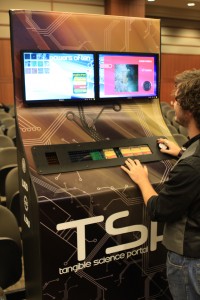
Imagine being able to see what would otherwise remain invisible; to touch the untouchable; to understand connections linking science at scales 1/1000th the size of an atom’s nucleus to the transgalactic. Now imagine K-12 students being able to do this, learning science in much the same way they play multiplayer video games.
Thanks to an LSU research team developing a kiosk with interactive technology for the Science Education Center at the Laser Interferometer Gravitational-Wave Observatory (LIGO) facility in Livingston, LA, that prospect is almost ready for launch. It will become a reality in October at LIGO SEC, Louisiana Tech, Southern University-Baton Rouge, and two Louisiana middle schools.
“In a good science classroom students have hands-on lab experiences with subjects like biology and chemistry. The LIGO challenge is that they are working with physical scales that normally remain inaccessible to direct physical experience,” says Dr. Brygg Ullmer, LSU Assistant Professor of Computer Science, who leads the kiosk design team.
Under the auspices of an NSF EPSCoR grant, the research team has been developing physical tools for scientists to collaboratively manipulate visualizations of phenomena like storm surge predictions and the movement of hurricanes. An additional $150,000 in BoRSF funding enabled the team to find ways to bring this technology to budding scientists through LIGO, giving K-12 teachers and students the opportunity to reach out and “touch” scientific content. Demonstrating the increasing potentials of this approach, a recently awarded $200,000 NSF CreativeIT grant will enable the team to support research outgrowths from the kiosks.
Read more…(PDF Document)
